Current issue
Displaying 1-17 of 17 articles from this issue
- |<
- <
- 1
- >
- >|
-
2025 Volume 42 Issue 2 Pages 50
Published: 2025
Released on J-STAGE: May 15, 2025
Download PDF (181K)
-
2025 Volume 42 Issue 2 Pages 51-53
Published: 2025
Released on J-STAGE: May 15, 2025
Download PDF (371K)
-
2025 Volume 42 Issue 2 Pages 54
Published: 2025
Released on J-STAGE: May 15, 2025
Download PDF (255K) -
2025 Volume 42 Issue 2 Pages 55-60
Published: 2025
Released on J-STAGE: May 15, 2025
Download PDF (2415K) -
2025 Volume 42 Issue 2 Pages 61-64
Published: 2025
Released on J-STAGE: May 15, 2025
Download PDF (917K) -
2025 Volume 42 Issue 2 Pages 65-71
Published: 2025
Released on J-STAGE: May 15, 2025
Download PDF (1070K) -
2025 Volume 42 Issue 2 Pages 72-78
Published: 2025
Released on J-STAGE: May 15, 2025
Download PDF (2198K) -
2025 Volume 42 Issue 2 Pages 79-83
Published: 2025
Released on J-STAGE: May 15, 2025
Download PDF (584K) -
2025 Volume 42 Issue 2 Pages 84-89
Published: 2025
Released on J-STAGE: May 15, 2025
Download PDF (1362K) -
2025 Volume 42 Issue 2 Pages 90-95
Published: 2025
Released on J-STAGE: May 15, 2025
Download PDF (1255K)
-
2025 Volume 42 Issue 2 Pages 96-101
Published: 2025
Released on J-STAGE: May 15, 2025
Download PDF (1111K) -
2025 Volume 42 Issue 2 Pages 102-107
Published: 2025
Released on J-STAGE: May 15, 2025
Download PDF (2925K)
-
2025 Volume 42 Issue 2 Pages 108-128
Published: 2025
Released on J-STAGE: May 15, 2025
Download PDF (2140K)
-
2025 Volume 42 Issue 2 Pages 129-130
Published: 2025
Released on J-STAGE: May 15, 2025
Download PDF (266K)
-
2025 Volume 42 Issue 2 Pages 131-135
Published: 2025
Released on J-STAGE: May 15, 2025
Download PDF (296K) -
2025 Volume 42 Issue 2 Pages 136
Published: 2025
Released on J-STAGE: May 15, 2025
Download PDF (104K) -
2025 Volume 42 Issue 2 Pages 137
Published: 2025
Released on J-STAGE: May 15, 2025
Download PDF (162K)
- |<
- <
- 1
- >
- >|
